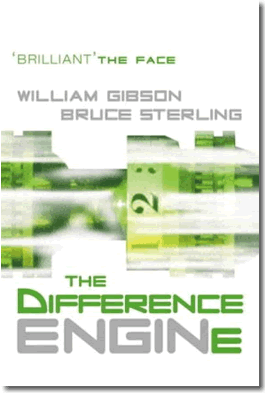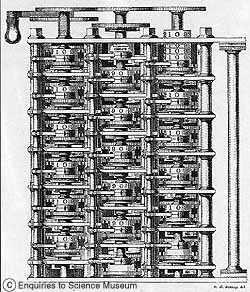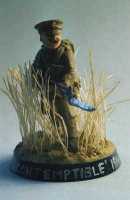The Difference Engine
"In the mists down Knightsbridge a procession of some kind was moving steadily across the road. Ghostlike, blurred by distance and the fog, they appeared to be military gurneys, the squat treaded monsters of the Crimean war. Fog muffled a heavy chugging and the faint repeated clank of jointed iron. One after another they passed. Each gurney hauled a linked articulated caisson. These wains appeared to be canvas-shrouded cannon, with men, footsoldiers in canvas coloured drab, clustered atop the cannons like barnacles, with a sea-urchin bristle of bayonetted rifles."
Wargaming and the Analytical Engine
 |
|
 |
INTRODUCTION
This is a world, different, yet faintly familiar to our own. A world where the sun never sets on the British Empire, Queen Victoria is upon the throne, a world on the verge of an Industrial Revolution.
An Industrial Revolution that changed the world as it was then known. From the rural backward farming country grew an urban forward looking industrialised nation. Factories, mills, the steam engine and the railways, iron and steel works, all contributing to the revolution.
But this time, this Industrial Revolution is different, different to our own, this revolution has been enhanced by the arrival of the computer. Charles Babbage's Analytical Engine was not only built, it works. Information Technology pulsates through the economy, driven by steam powered cybernetic Engines. A world of steam dreadnoughts, calculating-cannons, machines guns, squat treaded gurneys.
This is a world, different, yet faintly familiar to our own, this is the world of The Difference Engine.
BACKGROUND
The premise behind The Difference Engine is based on historical fact. The authors of the book undertook hours of research on what Victorian England was really like and what it would be like if Engines did exist. In 1642, a Frenchmen, Blaise Pascal who was only 19, invented what was very likely - if we exclude the abacus - the world's first mechanical adding machine.
Around 1815, Charles Babbage invented an advanced mechanical calculator. Developing from this, he in 1834 produced the first drawings for what was then a very ambitious Analytical Engine, capable of performing any calculation that could be precisely described, it could even 'choose' how to proceed in the course of a calculation.
This Analytical Engine is what today we would call a computer.
However, the extremely costly Engine, which required thousands of finely engineered mechanical gears, was according to most current experts way beyond the the capabilities of Victorian Engineering, and the Engine was thus never completed.
In the world of The Difference Engine, the Analytical Engine is not only built, it works. The result, a technological revolution, to quote the back cover of the book, "the computer age has arrived a century ahead of time."
The book, The Difference Engine, written by William Gibson and Bruce Sterling, published by Gollancz, price £4.99, is set in 1855, the simple working Analytical Engine has been improved and enlarged. Engines are now huge taking up whole buildings. Scotland Yard has the Victorian equivalent of the Police National Computer. Engines enter everyday life, from pocket steam engined sewing machines, to Engines set up to run kinotropes (or computer graphical presentations as you and I would call them).
 |
It even pervades the world of the military with Engines in use in construction of weaponry and in their use on the battlefield.
This world will seem very similar to players of Space 1889, but there is no ether, Mars is a distant planet, however the pace in technology and advancements over our own Victorian age are similar. Landships rule the battlefield, but there are no aerial flyers. Below I have included a section on how you could combine The Difference Engine with Space 1889.
Politically, the world is similar to our own, Britain (with the Royal Navy) rules the waves and has a huge Empire of colonies to provide her with all her raw materials. Aided by advances in Information Technology, Britain, all be it London, is the centre of the world.
Britain is at war with Russia in the Crimea, Imperial France is our staunchest ally, with Waterloo seen as a misunderstanding caused by the tyrant Wellington.
America is in turmoil, about to launch into one of the bloodiest civil wars ever. Texas and the other southern states continually quarrel with the more advanced north.
On the home front, a new political force rules the country, the Radical Party. Wellington and the Tories resenting the threat to their lifestyle by this technological revolution tried to suppress this new party with new laws and by force of arms. However popular support won the day and the Rad Party took power.
WEAPONRY
"There were soldiers with bayonetted rifles on the street-corners in Piccadilly, in modern speckled drab and slouch hats."
The Industrial Revolution was a time when new advancements in all areas, such as transportation and engineering, turned Britain from an european nation to a world super-power. There were also major advances in weaponry. In the early 1800s, the main infantry weapon was the musket and Nelson's Victory was the flagship of the Royal Navy By 1899, the soldier was armed with breech loading rifles and machine guns, whilst the navy now had armoured dreadnought "battleships". With the power of The Difference Engine, the advancement is now more rapid. The steam engine, developed to power pumps that extracted water from deep coal mines, aided the Industrial Revolution, bringing about the railway engine, thus mass transportation and the tractor, which in the world of The Difference Engine led directly to the gurney.
 |
Some excellent pictures of steam-powered transport.
The gurney is now the main means of transportation within the cities and on the battlefield. The military gurney, is a squat treaded armoured fighting vehicle, painted in camouflage to obscure it from the sights of the enemy guns. It normally tows artillery, but some are armed with mounted field guns behind gun shields (read tanks). Some excellent pictures of Victorian Landships.
Artillery officers use to use sights and mathematics for observation and targeting. Field guns now have Engines, which aid the officer in targeting, resulting in more accurate rapid fire. These calculating cannons are not only land-based but also mounted on the ships of the Royal Navy.
The ships of The Royal Navy are numerous and diverse and rule the waves. From steam dreadnoughts to ironclad river monitors, armed with the latest calculating cannons and machine guns.
The gatling gun revolutionised warfare to be only defeated by the tank, thus the machine gun is a major weapon with the British military, its effectiveness is somewhat diminished by the power of the armoured gurney.
Space 1889 is another good source of ideas for new weapons that could be used and this is explored in a later section.
WARGAMING & SCENARIOS
There is very little in the book that can be directly used on the gamer's table, apart from the riot/revolt scene that occurs towards the end of the book. But there is a lot of indirect information and background material that can be taken and used.
 |
Imagine the Charge of the Light Brigade, this time not with cavalry, but with squat, treaded armoured vehicles, the mass Russian cannon bouncing off the ironclad sides - the outcome may have been slightly different to what is written in the history books. Other Crimean actions offer many scenarios - mass battles are one option, though I personally favour skirmish actions involving small number of figures. For an example, a British steam gurney is ambushed by a small number of Russian soldiers in a brave (yet foolish) attempt to capture it.
British Ironclads and Russian ships clash in the Black Sea, the British are outnumbered and the Russian shore batteries don't help, can they win? Peter Pig's "Hammerin' Iron" rules are ideal for this sort of action.
The French have built a minaturised Engine of some phenomenal power which, according to some experts, could even be used in a guided rocket so some sort. The research is based in a Chateau on the Normandy coast near the town of Dieppe. Under the cover of darkness a force of specially selected soldiers are to be landed on the beach just before dawn. Armed with the latest weaponry, including some of the newest machine guns. The mission, enter the chateau under the cover of darkness, find the new Engine, remove it if possible or destroy it and the research, then return to the beach to be picked off by the Royal Navy. It is essential that the French armed forces do not discover your true identity otherwise relations between the two countries could be come somewhat strained.
Towards the end of the book is a riot/revolt episode where "luddites", communists and other alleged radical subversives attempt to take over London (well not quite, but I don't want to give away the whole plot). The government, who certainly didn't worry about world opinion at the time (no United Nations and America was just a nation of colonial upstarts allegedly) send in the army to restore order. Armed with steam gurneys, bayonetted rifles and artillery, they would stop at nothing to protect the government of the day. Barricades are on the streets, rioters armed with all manner of weaponry prepare themselves.
Here I have tried to offer some scenario ideas for the gamer wanting to game a few battles set in thr world of The Difference Engine, you could also check out some historical scenario ideas from the Crimea and the American Civil War for additional inspiration.
For rules, as well as writing your own, as seems favoured by many a gamer, you could also convert a commercial set. One of the obvious sets, is the Soldier's Companion for Space 1889, but as I have mentioned I think in a previous article you could also use Warhammer. Okay maybe not.
ROLE-PLAYING
The book does however offer much more for the role-player. Willian Gibson, one of the co-authors is well known for his Cyberpunk books, Neuromancer and Count Zero to name two. The Difference Engine can be seen to be a Victorian interpretation of Cyberpunk - thus makes an ideal background to introduce players of games such as Cyberpunk, Shadowrun and others of a similar ilk to Space 1889 (and even Call of Cthulhu). Conversely, you can go the other way take players from 1889 and introduce them to the high-tech world of Cyberpunk.
Utilising some system such as Space 1889 or Cthulhu by Gaslight (or even Boot Hill I suppose), a credible role-playing environment can be created. To expand on role-playing in The Difference Engine is beyond the scope of this article.
MODELS & FIGURES
The gamer has a wide choice of figures and scales from which to use for games in the world of The Difference Engine. Both the Colonial period and the Crimean War are well catered for, and are ideal. For those 25mm gamers use to the style of figure that manufacturers such as Citadel, Forge, Alternative and Grenadier make, then I would suggest you contact Wargames Foundry as they cover both eras, and their figures are designed by the same people who design Citadel Minatures.
For those who are use to the style - and the low cost of - historical figures the number of manufacturers that are around are too numerous to mention, so check out one of the "historical" magazines, for example, Practical Wargamer. However I will mention the 6mm or 1/300 range from Heroics and Ros who produce a wide range of figures in this dimunitive scale.
 |
For the military gurneys and other Difference Engine exotica, the descriptions given in the book are minimal, so use of imaginative licence is possible. For the 25mm gamer and mentioned many times in too many magazines, for use in Space 1889, are the possibilities of the Citadel plastic kits for Warhammer 40,000 - the World War One style of the Land Raider and the Rhino makes them both ideal for conversion into Victorian Landships. Another possible kit ripe for conversion is the new Emhar 1/35 kit of the WWI Mark IV Tank (Female). All these kits can have steam engines fixed on (use OO gauge steam engine model kits from Dapol for parts). Crewed by machine gunners and rifleman. I am currently working on a idea for a landship model for Space 1889, using a Citadel Land Raider. The back will comprise the motive power in the form of a steam engine, with cylinders, gear wheels and a smoke stack. Where the las-cannons are situated I am substituting with machine gun crews from the Wargames Foundry Boer War range behind armoured gun shields. At the front is a snow plough/cow catcher and to finish the model off, after being painted battleship grey, will be the white ensign of the Royal Navy. This model will also be used in games based in the world of The Difference Engine, but I think I will have to paint on some camouflage.
For those who game in 15mm, the 1/76 Airfix WWI tank and the Minifigs 15mm WWI range are options that can be utilised. Certainly most WWI equipment can be converted for use in Difference Engine games. Also, check out your local model railway shop, as the OO gauge range is ideal for 15mm - steam engines, steam powered trucks and other useful stuff can be used for and in conversions.
Down at 6mm, Irregular Models produce a WWI range, and Citadel also produce their Land Raider and Rhino models in this scale. Converting in this scale is not only simpler (and easier) but also a darn sight cheaper.
Actual models depends on your own interpretations of the descriptions given in the book, my own interpretation is of a technology looking similar to that of the early part of this century. The book has a very gothic feel to it so that even those Citadel Space Marine models could be used.
SPACE 1889
Games Designer Workshop's excellent role-playing system, Space 1889 is a favourite of many a gamer. The Difference Engine is almost crying out to be incorporated into the world of 1889.
Of course forty years separate these two different realities, there are three (of many) possibilities:
Bring forward The Difference Engine to the 1880's. It seems to make some kind of logical sense that the only possible way that ether flyers could be designed, built and flown the millions of miles across the ether is with the use of some kind of computing technology. Also try to work out what has happened in the world following the introduction of the Analytical Engine in those forty years. Looking at our own world since the introduction of the computer, we can see that they have got smaller. With the Engines depending on mechanical gears, with the aid of Engines, I think we can assume that these new smaller precise gears could be manufactured easily with the help of Engine controlled lathes and other machinery. Computers in our world have also grown more powerful and have penetrated every aspect of civil and military life. In our alternative reality, this could be seen as more efficient and accurate weaponry. Guided missiles could even be a possibility.
Another option is to put the Space 1889 universe back forty years, so discovery of the ether and life on Mars all happened forty years earlier than described in the game. This produces some inconsistencies, did Edison discover the Ether drive or was it someone else? However this does stop the era becoming too technologically advanced as could happen with the first option.
 |
A final option, and this is more of a compromise, is to set your games around 1870, this will allow you to have the best of both worlds.
Check our our Space 1889 section.
CONCLUSIONS
Ridley Scott described The Difference Engine as "a visionary steam-powered heavy metal fantasy... a high-Victorian virtual reality of extraordinary richness and detail."
Within this article I have had to make more than few assumptions about the world of The Difference Engine. this is because though the book has some information on weaponry and the armed forces, the main plot of the book is not concerned with military matters. What I have hoped to show in this article is the possibilities for gamers in the Victorian Science-Fantasy world of The Difference Engine.
The Difference Engine was written by William Gibson and Bruce Sterling, is published by Gollancz from all good bookstores. Order The Difference Engine from amazon.co.uk.







